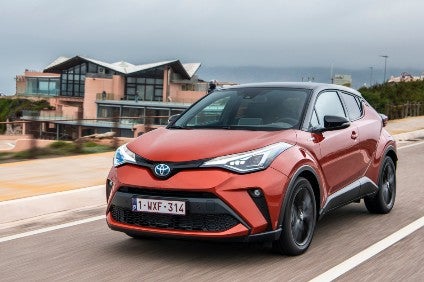
Toyota's C-HR crossover – launched in 2016 – has had a mid-life update and the 2020 model line for the UK follows other recent new models by going all-hybrid.
That means the existing 1.8-litre hybrid powertrain is joined by a more powerful, two-litre alternative, similar to the Corolla (nee Auris) line.

Discover B2B Marketing That Performs
Combine business intelligence and editorial excellence to reach engaged professionals across 36 leading media platforms.
Toyota claims the C-HR will be unique in its class by offering two different hybrid powertrains.
The petrol-only 1.2 engine has been dropped and the 120bhp 1.8-litre hybrid upgraded with a lithium ion high voltage battery – in place of the previous nickel-metal hydride unit – plus weight and efficiency improvements in all its principal components.
Around 120,000 of the distinctive crossovers were sold across Europe in launch year 2016, for a 10% segment share.
Here in the UK, 14,600 were sold in the first full year.
The Europe tally to date is about 400,000 and 50,000 of those in the UK.
Hybrid versions have accounted to 80% of sales; the only way to get a manual transmission was to opt for the non-hybrid 1.2.
So adding an extra hybrid engine makes sense.
The new two-litre system produces 182bhp, with CO2 emissions from 92g/km (NEDC correlated data)/119g/km (WLTP data) and is based around a petrol engine with maximum thermal efficiency of 41% which Toyota claims is the world's highest level for a mass-produced engine.
The 2.0-litre versions also have uprated suspension and improved noise and vibration countermeasures.
A new multimedia system incorporates Apple CarPlay and Android Auto and this also enables over-the-air map updates for the navigation system. A three-year subscription for updates (every six months) is included in the crossover's price.
The touchscreen is now supplemented by some buttons and dials for functions such as volume control.
UK grade structure is much as before with the entry Icon offered only with the improved 1.8-litre hybrid powertrain, followed by Design grade, which can also be specified with the new two-litre system.
Excel and Dynamic are the top models and there is also a 500-unit launch model with Scorched Orange paintwork, 18-inch matt black alloy wheels and black bi-tone roof, not dissimiliar in appearance to Volvo's sell-out XC40 First Edition.
This builds on Excel equipment specification with the JBL premium audio system and is a two-litre-only version.
First deliveries start in January 2020.






